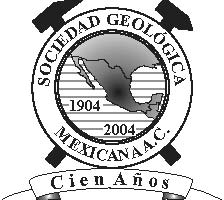|
BOLETÍN DE LA SOCIEDAD GEOLÓGICA MEXICANA VOL. 59, NÚM:. 1, 2007, p. 63-70 http://dx.doi.org/10.18268/BSGM2007v59n1a5 |
 |
Formación de megacristales naturales de yeso en Naica, México
Juan Manuel García-Ruiz1,*, Roberto Villasuso2, Carlos Ayora3, Angels Canals4 y Fermín Otálora1
1 Instituto Andaluz de Ciencias de la Tierra, Consejo Superior de Investigaciones Científicas-Universidad de Granada, Campus Fuentenueva, E-18002 Granada, España.
2 Compañía Peñoles, Unidad Naica, Naica, Chihuahua, México.
3 Institut de Ciències de la Terra Jaume Almera, Consejo Superior de Investigaciones Científicas, Lluis Solé Sabarís s/n, E-08028 Barcelona, España
4 Departament de Cristallografia, Mineralogia i Dipòsits Minerals, Universitat de Barcelona, Martí Franquès s/n, E-08028 Barcelona, España
* This email address is being protected from spambots. You need JavaScript enabled to view it.
Abstract
Exploration activities in the mine of Naica (Chihuahua, Mexico) recently unveiled several caves containing giant, faceted and transparent single crystals of gypsum (CaSO4·2H2O) up to eleven meters in length. From a crystallization point of view, it can be expected that the formation of these large crystals occur at very low supersaturation, the problem being to explain how proper geochemical conditions can be sustained for long time without large fluctuations that would trigger substantial nucleation. Fluid inclusions analyses show that crystals grew from low salinity solutions at a temperature around 54°C, slightly below the one at which the solubility of anhydrite equals the one of gypsum. Sulfur and oxygen isotopic composition of gypsum crystals is compatible with the growth from solutions resulting from dissolution of anhydrite previously precipitated during late hydrothermal mineralization, suggesting that these megacrystals formed by a self-feeding mechanism driven by solution mediated anhydrite-gypsum phase transition. Nucleation kinetics calculations based on laboratory data show that this mechanism can account for the formation of these giant crystals, yet only when operating within the very narrow range of temperature, identified by our fluid inclusions study. These singular conditions create a mineral wonderland, a site of scientific interest, and an extraordinary phenomenon worthy of preservation.
Keywords: Gypsum, selenite, crystallization, mineral growth, megacrystals, anhydrite, Naica, nucleation kinetics, fluid inclusions.
|
Versión castellana del artículo “Formation of natural gypsum megacrystals in Naica, Mexico” de los mismos autores. This paper was published in the journal GEOLOGY, Volume 35, Issue 4 (April 2007), pp. 327-330. It can be accessed at <<http://www.geosociety.org/pubs/>>. Copyright © 2007, The Geological Society of America, Inc. (GSA). All rights reserved. |

